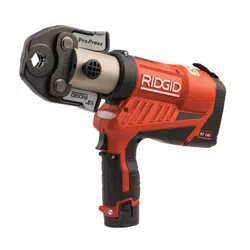Loading ...
Loading ...
Loading ...

• When battery pack is not in use, keep it
away from other metal objects, like pa -
per clips, coins, keys, nails, screws or
other small metal objects that can make
a connection from one terminal to an-
other. Shorting the battery terminals to-
gether may cause burns or a fire.
• Do not burn battery or expose to high
temperatures. High temperatures can
cause the battery to explode.
• Properly dispose of batteries. Do not
burn. When disposing, place tape over bat-
tery terminals to prevent shorting. Batteries
are Li-Ion and should be recycled. Follow all
applicable local regulations for disposal of
batteries. Refer to Disposal section.
The EC Declaration of Conformity (890-011-
320.10) will accompany this manual as a sep-
arate booklet when required.
If you have any question concerning this
RIDGID
®
product:
– Contact your local RIDGID
®
distributor.
– Visit RIDGID.com or RIDGID.eu to find
your local Ridge Tool contact point.
– Contact Ridge Tool Technical Service
Department at rtctechservices@emer-
son.com, or in the U.S. and Cana da call
(800) 519-3456.
description And
Specications
description
The RIDGID
®
RBC-121 12V Lithium-Ion Battery
Charger is designed to charge the RIDGID
®
12V RB-1200 Series Lithium-Ion Batteries (as
listed in the Optional Equipment section). This
charger requires no adjustments. The charger
includes LED lights to indicate battery charge
state and charger condition.
Figure 1 – RBC-121 Lithium-Ion Battery
Charger
• Do not expose charger or battery to
damp or wet conditions, such as rain.
Make sure hands are dry when han-
dling. Moisture increases the risk of elec-
trical shock.
• Follow all charging instructions and do
not charge or store the battery pack
outside the temperature range speci-
fied in the instructions. Charging or stor-
ing improperly or at temperatures outside
the specified range may damage the bat-
tery and increase the risk of battery leak-
age, electrical shock or fire.
• This appliance is not intended for use
by persons (including children) with re-
duced physical, sensory or mental ca -
pa bi lities, or lack of experience and
knowledge, unless they have been giv -
en supervision or instruction concern-
ing use of the appliance by a person re-
sponsible for their safety.
• Children should be supervised to en-
sure that they do not play with the appli-
ance.
Battery Charger Safety
• Use an appropriate power source. Do
not use DC power. May cause damage to
charger resulting in electrical shock, fire or
burns.
• Do not allow anything to cover the
charg er while in use. Proper ventilation is
required for correct operation of charger.
Covering vents may result in fire. Allow a
minimum of 4" (102 mm) of clearance a -
round the charger for proper ventilation.
• Unplug the charger when not in use.
Reduces risk of injury to children and un-
trained persons.
• Do not carry charger by power cord. Do
not pull cord to unplug. Reduces risk of
electrical shock.
Battery Safety
• Avoid contact with battery fluids. Fluids
may cause burns or skin irritation. Thor -
oughly rinse with water in case of acci-
dental contact with fluid. Consult doctor if
fluid comes into contact with eyes.
• Use batteries only with equipment spe -
cifically designating their use. Using
equipment and batteries that are not rated
for use together can cause fire or other
personal injury.
3
RBC-121 Battery Charger
Cord
Loading ...
Loading ...
Loading ...
